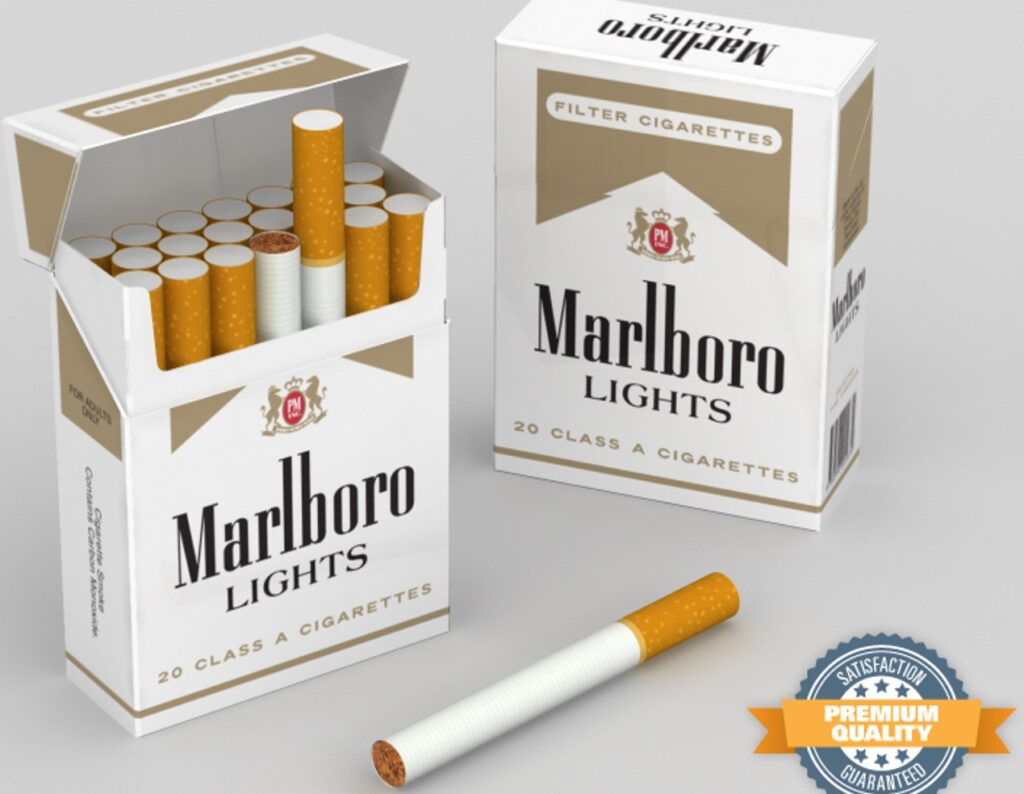Introduction
Marlboro Lights, a popular variant of the renowned Marlboro brand, have long held a significant place in the world of cigarettes. Known for their milder taste and perceived lower health risks, Marlboro Lights have attracted a wide array of smokers. But what truly sets them apart? This article delves into the intricate details of Marlboro Lights, exploring their history, unique characteristics, controversies, and much more.
History of Marlboro Lights
Origins of Marlboro
Marlboro’s roots can be traced back to the early 20th century, initially marketed as a premium cigarette for women. The brand’s iconic red and white packaging and the introduction of the Marlboro Man in the 1950s revolutionized its image, making it synonymous with rugged masculinity.
Introduction of Marlboro Lights
In response to growing health concerns and a demand for milder options, Marlboro Lights were introduced in the 1970s. Designed to offer a smoother smoking experience with lower tar and nicotine levels, they quickly gained popularity among smokers seeking a less harsh alternative.
Evolution Over the Years
Over the decades, Marlboro Lights have undergone various changes in packaging, formulation, and marketing strategies. Despite these changes, they have maintained their position as one of the top-selling light cigarettes globally.
What Makes Marlboro Lights Unique?
Taste Profile
Marlboro Lights are known for their balanced flavor profile. They offer a milder taste compared to regular Marlboro cigarettes, which many smokers find appealing for everyday use.
Packaging
The distinctive gold and white packaging of Marlboro Lights sets them apart. The sleek design not only attracts attention but also conveys a sense of sophistication.
Marketing Strategies
Marlboro Lights’ marketing has always emphasized a smooth and satisfying smoking experience. Advertisements often highlight the balance between flavor and smoothness, appealing to a broad audience.
The Controversy Surrounding Marlboro Lights
Health Concerns
Despite their name, Marlboro Lights are not significantly less harmful than regular cigarettes. Studies have shown that smokers often compensate by inhaling more deeply or smoking more cigarettes, negating any potential benefits of reduced tar and nicotine levels.
Misleading Advertising Claims
For years, Marlboro Lights were marketed as a healthier alternative to regular cigarettes. This led to numerous lawsuits and regulatory actions, as these claims were deemed misleading.
Regulatory Actions
Regulatory bodies have cracked down on the use of terms like “light” and “mild” in cigarette branding. These actions aim to prevent the false perception that such products are safer.
Ingredients and Composition
Tobacco Blend
Marlboro Lights use a specific blend of tobaccos to achieve their milder taste. This blend is carefully selected to balance flavor and smoothness.
Additives and Chemicals
Like all cigarettes, Marlboro Lights contain various additives and chemicals to enhance flavor and preserve freshness. These include humectants, flavorings, and combustion aids.
Comparison with Regular Marlboro
Compared to regular Marlboro cigarettes, Marlboro Lights have lower levels of tar and nicotine. However, the difference is not as significant as some might believe.
Smoking Experience
Flavor and Aroma
Marlboro Lights are praised for their smooth flavor and pleasant aroma. The milder tobacco blend provides a more refined smoking experience.
Smoothness and Throat Hit
One of the key selling points of Marlboro Lights is their smoothness. The reduced harshness makes them a preferred choice for many smokers.
User Testimonials
Many smokers describe Marlboro Light,s as their go-to cigarette for daily smoking. They appreciate the balance of flavor and smoothness, making it a reliable choice.
Marlboro Lights vs. Other Light Cigarettes
Comparison with Other Brands
Marlboro Light,s are often compared to other light cigarettes like Camel Lights and Newport Lights. Each brand has its unique flavor profile and loyal customer base.
Market Position
Marlboro Light,s hold a strong position in the market, often leading in sales compared to other light cigarettes. Their brand recognition and consistent quality contribute to their success.
Consumer Preferences
Consumer preferences vary, but many smokers prefer Marlboro Light,s for their reliable taste and smooth smoking experience. This preference keeps them at the forefront of the market.
Marketing and Advertising Strategies
Historical Ad Campaigns
Marlboro Light,s ad campaigns have evolved over the years, from highlighting their mildness to emphasizing lifestyle and satisfaction.
Target Demographics
The brand targets a wide demographic, appealing to both younger and older smokers. The emphasis on smoothness and style resonates with a broad audience.
Modern Advertising Approaches
In recent years, Marlboro Light,s have adapted their advertising to comply with stricter regulations. Digital marketing and subtle branding now play a significant role.
Impact on Popular Culture
Appearance in Movies and Media
Marlboro Light’s have made numerous appearances in films and TV shows, often associated with characters seeking a sophisticated or laid-back image.
Celebrity Endorsements
While direct endorsements are less common today, the brand has historically been linked with various celebrities, enhancing its cultural footprint.
Cultural Symbolism
Marlboro Light’s symbolize a blend of sophistication and rebellion, making them an iconic choice for many smokers.
Health Implications
Risks Associated with Light Cigarettes
Despite being marketed as “light,” Marlboro Light’s pose similar health risks as regular cigarettes. The misconception of reduced harm has been debunked by numerous studies.
Studies and Research Findings
Research indicates that light cigarettes do not significantly reduce the risk of smoking-related diseases. The deeper inhalation and increased frequency of use counteract the lower tar and nicotine levels.
Public Health Perspectives
Public health experts advocate for awareness and education about the risks of all cigarette types, including Marlboro Light’s. The goal is to dispel myths and encourage cessation.
Regulatory Environment
Government Regulations
Governments worldwide have implemented strict regulations on cigarette advertising and packaging. Terms like “light” and “mild” are often banned to prevent misleading consumers.
Labeling and Packaging Laws
Labeling laws require clear health warnings on cigarette packs. Marlboro Light packaging must comply with these regulations, impacting their market presentation.
Impact of Regulations on Sales
While regulations have influenced marketing strategies, Marlboro Light’s continue to thrive due to their established brand and loyal customer base.
Global Market Presence
Availability in Different Countries
Marlboro Light’s are available in many countries, each with unique packaging and regulatory requirements. Their global presence underscores their popularity.
Sales Statistics
Sales data indicates that Marlboro Light’s remain one of the best-selling light cigarettes worldwide. Their appeal spans various demographics and regions.
International Marketing Strategies
Philip Morris International tailors its marketing strategies to fit local markets, ensuring Marlboro Light’s maintain their global appeal.
Consumer Perception and Behavior
Why People Choose Marlboro Lights
Smokers choose Marlboro Light’s for various reasons, including taste, smoothness, and brand loyalty. The perceived health benefits, despite being debunked, also play a role.
Psychological and Social Factors
Smoking habits are influenced by psychological and social factors. Marlboro Light’s branding and marketing tap into these elements, attracting a diverse customer base.
Trends in Smoking Habits
Trends show a gradual decline in smoking rates globally, yet Marlboro Light’s maintain a stable market share. This resilience reflects their strong brand presence.
Environmental Impact
Production and Waste
Cigarette production and disposal contribute to environmental pollution. Marlboro Light production process and packaging waste are part of this issue.
Environmental Initiatives by Philip Morris
Philip Morris has initiated programs to reduce the environmental impact of their products. These include sustainable farming practices and waste reduction efforts.
Future Sustainability Goals
Looking ahead, Philip Morris aims to enhance its sustainability efforts, focusing on reducing the environmental footprint of Marlboro Light and other products.
Conclusion
Marlboro Lights remain a prominent player in the cigarette market, despite controversies and regulatory challenges. Their unique blend of flavor, smoothness, and sophisticated branding continues to attract smokers worldwide. Understanding their history, composition, and impact helps consumers make informed choices. While Marlboro Light are not a safer alternative to regular cigarettes, their enduring popularity highlights the complex relationship between smokers and their preferred brands.
FAQs
Are Marlboro Lights less harmful than regular cigarettes?
No, Marlboro Light,s are not significantly less harmful than regular cigarettes. The reduced tar and nicotine levels do not substantially decrease health risks.
How have Marlboro Lights changed over the years?
Marlboro Lights have seen changes in packaging, formulation, and marketing strategies to comply with regulations and adapt to consumer preferences.
What do Marlboro Lights taste like?
Marlboro Lights have a balanced, mild flavor profile, offering a smoother and less harsh smoking experience compared to regular cigarettes.
Are there any alternatives to Marlboro Lights?
Yes, there are several alternatives to Marlboro Lights, including other light cigarettes like Camel Lights and Newport Lights, each with its unique taste and smoothness.
How can smokers quit Marlboro Lights?
Quitting Marlboro Light,s involves strategies such as seeking support, using nicotine replacement therapies, and adopting healthier habits. Consulting a healthcare professional can also provide personalized guidance.







